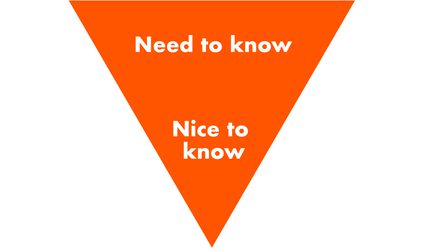How To: Write Great Web Copy
Before we get to the nitty-gritty, it's useful to understand how web copy is different from brochure copy.
You'd think us humans had got used to reading online by now? That we'd settled-in to it, and started reading from screens the way we do printed books and brochures. Nope. We continue to consume web content differently than we do print.
According to the world leaders in research-based user experience, we still skim-read online.
But the fact people probably won't read every word doesn't mean we should write-off our web copy.
Why your web copy is important
Even when people aren't reading every single word you've written, you still need to communicate the same information. You still need to convince them to join the mailing list, buy a ticket, or support your work with a donation. And you still need to convey your personality.
Not forgetting making sure search engines 'understand' what you've written. And that screen readers can skip-through your copy in a logical way.
Finally, let's also bear in mind that English isn't everyone's strongest skill – or first language. We audited 30+ arts and cultural websites and the average reading age needed to understand them was 25. The average reading age for adults in the UK is 9.
We audited 30+ arts and cultural websites and the average reading age needed to understand them was 25. The average reading age for adults in the UK is 9
For arts and culture to be accessible to everyone, people need to understand what you've written. Without needing a university-level command of the English language. And without having to read every single word.
How can you do this? By following a few principles of that thing we keep banging-on about – accessibility!
The benefits of writing in an accessible way are:
- It helps you reach a wider audience, simply because more people understand you.
- It helps you to structure content in a way that works both for humans, and search engines.
Practical tips for writing great web copy
1. Start with your main points
People skim-read – so start by telling them what they need to know.
Get across the broad idea of the page right up there in the headline and first few paragraphs. Follow on from that with supporting information, then general details. (This is sometimes called the inverted pyramid model, and is often used in journalism.)
This way of structuring your content is also helpful for search engines. Their spidery bots put more emphasis on the content that sits towards the top of a page.

TRY THIS: Create A Copy Skeleton
- Jot-down a list of keywords – a dozen or so – that cover-off everything you want to say.
- Rearrange these keywords/notes in order of importance. (Keeping 'need to know' stuff at the top of the list, followed by 'nice to know'.)
- Build-out each element of your list into prose. You might need to re-jig some of the sections as you go. That's fine. Just keep the important bits at the top.
👉 Remember to include a call-to-action at the end.
2. Know your audience – and write the way they talk
It's sometimes useful to imagine you're talking to a specific person. So, pick your primary audience and 'talk' to one of them when you're writing. This can help you to choose words, and make your writing sound more friendly.
Use 'you' when referring to your audience, and 'we' when talking about your organisation:
😐 Meh: "Generic Theatre's looking forward to welcoming audiences soon!"
🤩 Yeah: "We're looking forward to welcoming you soon!"
Beware of jargon. It may alienate folks outside of your organisation. Does your copy talk about 'productions' rather than 'shows'? 'Events' instead of 'gigs'? It helps you to sound more human and relatable when you use the same language as your audience.
Bonus: Using the same words as your audience helps search engines to find your website too – because these are the words people use as search terms
3. Write in short, simple sentences
Don't think of this as having to be dull or childish. Short sentences are great! They can add pace and excitement to your writing, while making it easier to read.
I find this tricky. My instinct is to string together loads of information in one long sentence. That ginormo-sentence then becomes over-complicated and hard to understand. Unlike the paragraph you're reading now. It was one huge, confusing sentence in my first draft. After a bit of editing, it's nice and clear.
I use a free online tool called Hemingway to help me edit and simplify copy. Handily, it also points out when I'm overdoing the adverbs. And failing to use the active voice …
4. Use the active voice
Using the active – rather than passive – voice helps create succinct, direct, reader-friendly sentences. “You can do it” is way more engaging than saying “It can be done".
😐 Meh: "Tickets can be purchased online"
🤩 Yeah: "You can buy tickets online" / "Buy tickets online"
If you're anything like me, you find it hard to work out when you're writing in the passive or active voice. Here're a few bookmarkable links to examples I find helpful:
5. Break it up
Sub-headings, bullet points, bold text, rich media – and breathing space
Easily digestible chunks of copy – with meaningful sub-headings – help people to skim-read. It's also good for search engines, and people using screen readers. Triple win for content-chunking!
Additionally:
- Use bullet points to make it easier to browse lots of information.
- Add Bold to emphasise important keywords or key points.
- Include 'rich media' like images, videos, and charts.
Each of the above will help to add breathing space to your copy. Ahhhhhhh!

6. Have fun with the words you use … while keeping some of them consistent
Of course, you need to use your tone of voice. But keep people interested and engaged by using different words every so often. Shake it up a little, so you don't end-up sounding samey.
You may find it useful to add some sample copy to a free word cloud generator. This'll help you identify which words you use (overuse?) most often. Thesaurus.com is handy for finding alternative synonyms.
What's that about being consistent?
Be consistent with certain key terms. For example, do you have a ‘Friends’ or ‘Members’ scheme? And is it a 'scheme'? Or a 'package', or 'plan'? Do you have 'audiences', 'patrons', or 'customers'? Keeping these sorts of words and phrases consistent helps people's understanding.
7. Have fun with how you say things
Always be clear and authentic, but consider how you might phrase things to make them sound interesting. (Headlines and calls-to-action in particular.) How will you get folks interested in this thing, and make them want to read more? Or take an action?
Some useful prompts for consideration:
- Tell people what they'll get from it
- Make 'em smile
- Make it emotional
- Create intrigue
- Defy expectation
I sometimes use the app Grammarly. It identifies the 'tone' of your copy e.g. formal, encouraging, confident, optimistic, joyful, friendly, etc.
But remember – clarity and authenticity above all else.
TRY THIS: Mix facts and feelings
Audiences love the arts. They're emotionally attached. So, use emotive language along with your stonecold facts.
😐 Meh: "Our Learning and Participation work can be supported by donating a ticket through our Education Fund"
🤩 Yeah: "Give a child the gift of theatre – book them a ticket to our next show"
The second example is more compelling as it gives people a clear picture of the impact of their support. People instantly imagine their 'gift' creating a life-changing experience for someone. (Good old active voice!)
Plus, it says more about you as an organisation.
It says that you want kids to come to your theatre. That you consider a donation a 'gift' – equating it with generosity and kindness. And you're even telling folks that you make your own shows. Noice!
8. Don't leave your audience at a dead-end
So, someone's reached the end of your page or article or whatever it is. Now what?
Your website may add a call-to-action automatically. For example, a list of related content. Even if that's the case, you might want to point folks towards something more specific:
"If you liked this, join our mailing list"
Linking to other pages on your own website is good for search engine optimisation.
It also keeps folks moving through the site. More pages viewed = more chance people'll find things they're interested in. And perhaps they'll sign-up to your mailing list. Or buy a ticket. Or, if you've done an especially great job, make a donation.
Always give people a 'next step'.
In summary
- Start with your main points
- Know your audience – and write the way they talk
- Write in short, simple sentences
- Use the active voice
- Break it up – with sub-headings, bullet points, bold text, rich media, and breathing space
- Have fun with the words you use … while keeping some of them consistent
- Have fun with how you say things
- Don't leave your audience at a dead-end
And an extra little nugget – if it makes sense to include a summary, include a summary.
Handy tools to bookmark:
Found this article useful? For more how-tos, news, insight, opinion, and what-not – join the Supercool mailing list
